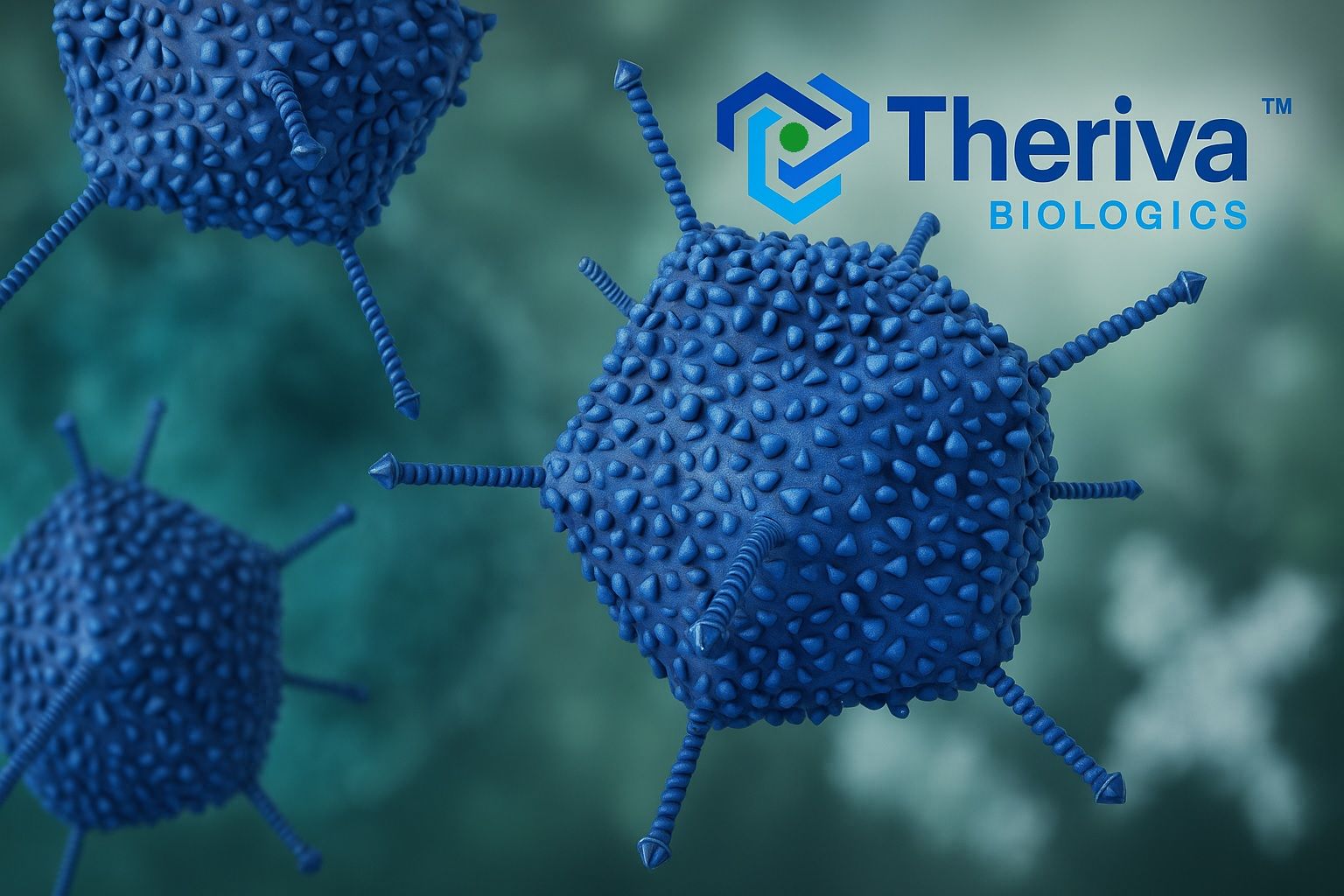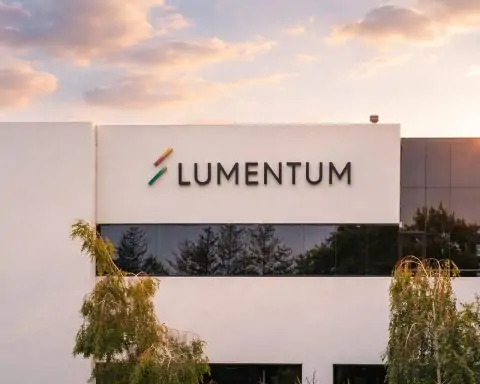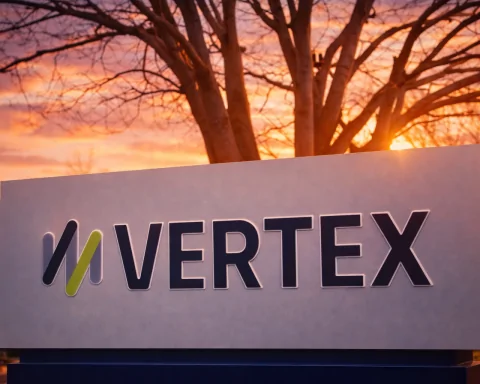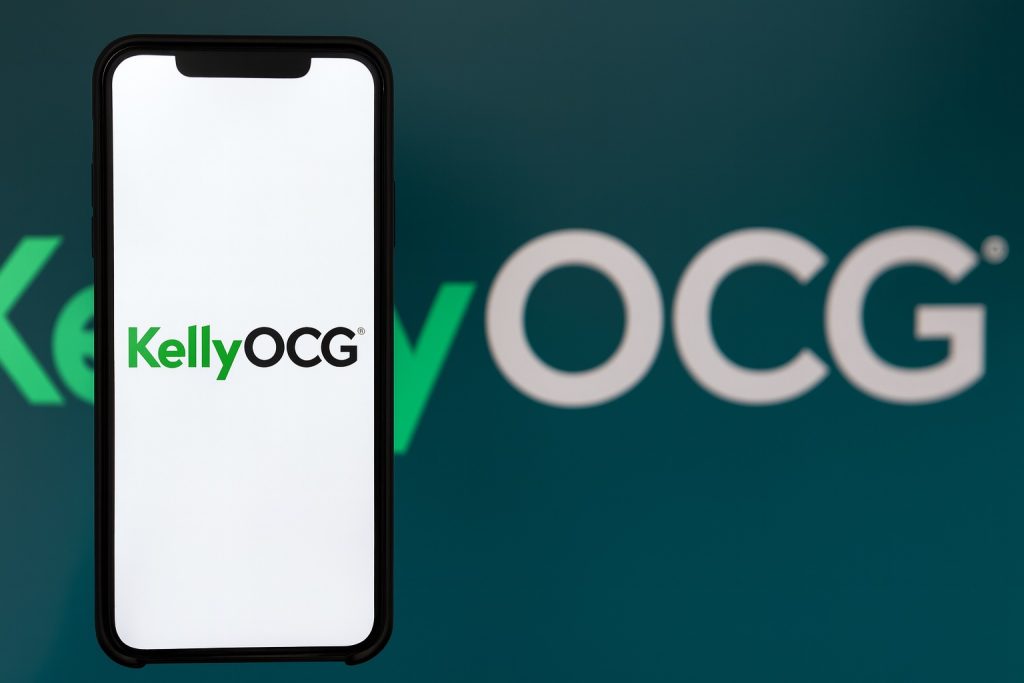- Stock Surge & Pullback: Theriva Biologics (NASDAQ: TOVX) shares soared 92% on October 15, 2025, jumping from ~$0.44 to $0.84 intraday on heavy volume [1] after positive trial news. The next day, shares retraced to the mid-$0.40s following a $4 million financing announcement, trimming the rally [2] [3].
- Trial Breakthrough: Theriva’s lead oncolytic virus VCN-01 achieved primary efficacy and safety endpoints in a Phase 2b trial for metastatic pancreatic cancer, significantly improving patient overall survival (OS) and progression-free survival versus standard chemo [4] [5]. The therapy was well-tolerated with only transient side effects [6].
- Fresh Funding: On Oct. 16, Theriva raised $4.0M via a warrant inducement deal, securing immediate cash by incentivizing warrant holders to exercise at $0.54 [7]. This boost adds to the $12.1M cash Theriva held as of mid-2025 (funding operations into Q1 2026) [8], shoring up its runway for upcoming trials.
- Analyst Outlook: Coverage is sparse – only 2 analysts cover TOVX (1 Buy, 1 Hold), yielding a consensus “Hold” [9]. Price targets are lofty (around $6.00–$7.00 per share) [10], implying >10x upside if Theriva’s clinical programs succeed. Such targets assume best-case outcomes (e.g. successful Phase 3 or a big partnership).
- Upcoming Catalysts: Theriva will present detailed Phase 2b results at the ESMO medical conference on October 20, 2025 [11], giving investors a deeper look at VCN-01’s data. The company is also sharing new data on its SYN-004 microbiome therapy at IDWeek on Oct. 20 [12]. These events, plus plans for a Phase 3 trial, could be key stock drivers in coming months.
Recent Clinical Developments and Pipeline Updates
Theriva Biologics – a Rockville, MD-based clinical-stage biotech – has made headlines with promising cancer trial results. On October 13, 2025, the company announced that expanded data from its VIRAGE Phase 2b trial in metastatic pancreatic ductal adenocarcinoma will be presented at the ESMO 2025 Congress on Oct. 20 [13]. In this trial, patients receiving VCN-01 (an oncolytic adenovirus therapy) plus standard gemcitabine/nab-paclitaxel chemo showed markedly better outcomes than chemo alone. Interim data filed with the SEC reveal VCN-01 improved median overall survival to around 11–14 months versus ~8–11 months for chemo-only patients [14]. Notably, patients who received two doses of VCN-01 (before the 4th chemo cycle) had median OS of ~14.8 months vs. 11.6 months for chemo alone – a substantial gain in this aggressive cancer [15]. The study met its primary endpoints, with VCN-01 demonstrating a tolerable safety profile and only transient, reversible side effects [16]. These positive results – essentially a breakthrough in pancreatic cancer, which notoriously has a very low survival rate – have fueled optimism about Theriva’s approach.
Theriva’s pipeline extends beyond pancreatic cancer. In retinoblastoma (a rare eye cancer), VCN-01 is also being studied. At ASCO 2025, investigators presented Phase 1 data in children with chemo-refractory retinoblastoma, showing a “tolerable toxicity profile and encouraging response” [17]. Renowned retinoblastoma specialist Dr. Guillermo Chantada noted “VCN-01 is a promising new player … we found it specifically targets the tumor cells”, suggesting it could avoid the side effects of chemotherapy or radiation [18]. This early success in a pediatric cancer earned VCN-01 FDA Orphan Drug and Rare Pediatric Disease designations for retinoblastoma, on top of its Orphan Drug and Fast Track status in pancreatic cancer [19].
The company is already preparing next-generation therapies. At the European Society of Gene & Cell Therapy (ESGCT) conference in early October, Theriva’s collaborators presented preclinical data on VCN-12, a new “armed” oncolytic adenovirus derived from VCN-01 [20]. VCN-12 is engineered for enhanced tumor cell lysis, better tumor stroma degradation, and stronger immune activation than VCN-01. The ESGCT update also noted research into delivering VCN-01 directly into the brain – indicating potential use of Theriva’s viruses for hard-to-treat brain tumors [21]. This hints at a broader vision where Theriva’s platform could target multiple tumor types and routes of administration.
Beyond virotherapy, Theriva has a separate focus on microbiome protection. Its candidate SYN-004 (ribaxamase) is an oral enzyme aimed at protecting gut flora during intravenous antibiotic treatment. SYN-004 is in a Phase 1b/2a trial in allogeneic bone marrow transplant patients, where gut microbiome damage from antibiotics can trigger dangerous complications like graft-versus-host disease. Theriva will present interim safety and pharmacokinetic results for SYN-004 in a poster at IDWeek 2025 on Oct. 20 [22]. Early indications suggest SYN-004 is well-tolerated, and investors will be keen to see if this unique therapy can reduce infection rates or GVHD in these patients.
In summary, Theriva’s recent news flow underscores a diversified pipeline firing on multiple cylinders: a lead oncolytic virus nearing Phase 3 in pancreatic cancer, exploratory use of that virus in eye and brain cancers, a next-gen virus in preclinical development, and a novel enzyme to prevent post-antibiotic complications. This breadth is somewhat unusual for a micro-cap biotech and has become part of the bullish narrative around the stock.
Stock Price Movement and Notable Volatility
Theriva’s stock price has been on a roller coaster ride in October. On October 15, 2025, TOVX stock skyrocketed ~92% in a single day, closing around $0.84 (from the prior day’s $0.44 close) [23]. Intraday, shares traded as high as ~$0.86 [24], as excited investors rushed to buy on the oncology breakthrough news. Volume exploded to many times the normal level – traders exchanged tens of millions of shares on Oct. 15 versus roughly 1 million shares the day before, an extreme turnover for a company with only ~9–10 million shares in public float [25]. This kind of spectacular one-day leap is atypical, even in the volatile biotech sector, and reflected both genuine positive sentiment and possibly a short-squeeze or momentum trading.
The surge snapped a long downtrend for Theriva. Just a year ago, in late 2024, the stock hit a 52-week high of $2.64, but throughout 2025 it had steadily slid into the $0.30–$0.50 range [26] amid dilution and the typical cash burn of a clinical-stage biotech. By mid-2025, shares were languishing near all-time lows (~$0.37 at one point) [27]. The Oct. 15 rally thus caught many by surprise – the stock gapped up from $0.44 and never looked back that day, closing at its highs in what chart analysts would call a bullish engulfing candlestick. Some traders saw this as a potential trend reversal, noting that the move took out several technical resistance levels. The sudden burst even likely yanked certain momentum indicators (like RSI and MACD) from oversold into more neutral territory [28]. In short, Theriva went from an overlooked penny stock to one of the day’s top gainers.
However, volatility cuts both ways. The very next session – Oct. 16 – Theriva’s stock plunged over 50% intraday, falling back into the ~$0.40–$0.45 range [29]. The catalyst was the company’s morning announcement of a warrant inducement financing: essentially, Theriva agreed to temporarily lower the exercise price of 7.36 million existing warrants to $0.54 (from $1.10) to prompt holders to exercise them immediately, netting the company $4.0 million in cash [30]. In exchange, those investors will receive new warrants for additional shares (at $0.54 strike) as a sweetener [31]. While this deal strengthens Theriva’s cash position, it also dilutes existing shareholders by potentially adding over 7 million shares now (and up to ~14.7 million more if the new warrants are approved and exercised) [32] [33]. The stock’s sharp pullback on Oct. 16 showed that traders quickly took profits and reacted to the dilution – a common pattern in micro-cap biotechs where any capital raise, even a necessary one, can hammer the share price. By midday Oct. 16, TOVX hovered around $0.42 [34], roughly where it was before the big rally, demonstrating how fragile gains can be without follow-through news or buyers.
Theriva’s ultra-low float amplifies these swings. With only ~9.6 million shares in the float [35] (and a similar number outstanding in total), even modest trading interest can send the price lurching up or down. Indeed, online investor forums pointed out that such a tiny market cap (~$4 million) and share count mean outsized moves are possible on any development – for better or worse. Some traders on platforms like StockTwits noted the stock’s sudden popularity and warned others of the volatility: “This one moves fast; know your risk,” was a common refrain. Short interest in TOVX was around 3%–5% of the float (a few hundred thousand shares) before the spike, and reportedly many shorts scrambled to cover during the 92% surge [36]. That short covering likely added fuel to the rally. However, after the financing news, short sellers may return, betting that the stock could drift lower again until Theriva delivers its next catalyst. All told, TOVX has shown textbook micro-cap biotech volatility: massive upside on a breakthrough narrative, followed by whiplash-inducing swings as the realities of financing and execution set in.
Analyst Insights and Commentary
Given Theriva’s small size, Wall Street analyst coverage is minimal. Reuters indicates just two analysts currently rate TOVX – one with a Buy recommendation and one with a Hold, averaging out to a lukewarm “Hold” consensus [37]. There have been no major new analyst research notes immediately following the recent trial news, which isn’t unusual for a nano-cap stock. However, previous analyst forecasts reveal striking optimism: MarketBeat and Investing.com list 12-month price targets around $6.00–$7.00 [38]. Even the lower end of that range would imply roughly a 600%+ gain from the current ~$0.40 price. Such aggressive targets suggest that those analysts envision Theriva successfully completing Phase 3 trials and possibly securing a partnership or FDA approval down the line. It’s a reminder that if everything goes right, micro-cap biotechs can multiply in value – but that “if” is significant. For now, the consensus stance is effectively wait-and-see, reflecting the considerable clinical and regulatory hurdles still ahead.
No mainstream investment banks have active coverage on Theriva, but the stock’s wild ride has attracted attention from financial bloggers and trading communities. One market newsletter highlighted Theriva’s 92% jump, attributing it to the company’s “expanded data” announcement and calling the oncolytic virus results “encouraging for an indication [pancreatic cancer] that desperately needs new options.” The author noted that such a large move in one day is rare and speculated it “could mark a sentiment shift, though it’s too early to call it a sustained turnaround.” On social media, many retail traders cheered the win, circulating the press release details and dubbing VCN-01’s early results a “game changer” for Theriva if confirmed in larger trials. Cautious voices were present too: some users pointed out that Theriva has no revenues (as a pre-commercial biotech) and will need to raise more funds in the future, urging others not to “fall in love” with a penny stock. This mix of exuberance and caution is typical in small biotech investing – believers focus on the scientific upside, while skeptics focus on the financial risks.
Notably, Theriva’s management appears confident. In the Q2 update, CEO Steven A. Shallcross said, “We have achieved a significant milestone with the positive readout from the Phase 2b VIRAGE trial… We are now preparing a study protocol for a potential Phase 3 clinical trial and advancing VCN-01’s manufacturing scale-up” [39]. He added that the company has initiated partnering discussions for VCN-01’s late-stage development [40]. This statement – coming before the recent stock spike – shows management was already laying groundwork for the next steps, which is an encouraging sign for analysts and investors. It suggests Theriva isn’t content with just a one-time data win; they are actively planning the path to market (or to a larger partner who could help commercialize the therapy). Analysts will be watching for any official partnership deals or Phase 3 trial initiation news, as those would validate the CEO’s roadmap and could significantly de-risk the program.
From an expert perspective, the scientific community is taking note of Theriva’s work, albeit quietly. The fact that ESMO (a top European oncology conference) selected Theriva’s trial data for presentation indicates a level of peer recognition. Additionally, the involvement of key opinion leaders like Dr. Chantada in the retinoblastoma study and Dr. Rocío García-Carbonero (the Spanish oncologist slated to present the VIRAGE data at ESMO [41]) lends credibility. If these experts speak positively about the results during conferences, it can bolster investor confidence. On the other hand, any critical questions or skepticism raised publicly (for instance, about trial design or statistical significance) could temper the enthusiasm. So far, early commentary from investigators has been upbeat – emphasizing that VCN-01 offers a novel mechanism (using a virus to break down tumor protective barriers and stimulate immune attack [42]) that could synergize with existing treatments. This aligns with a broader excitement in oncology around oncolytic viruses as an emerging modality. In short, while formal analyst coverage is light, there are voices in the biotech community quietly endorsing the potential they see in Theriva’s approach.
Financial Health and Biotech Market Context
Theriva Biologics’ financial position is a tale of careful cash management common to small biotechs. The company ended Q2 2025 with $12.1 million in cash on hand [43], which it estimated was enough to fund operations into Q1 2026 [44]. Since then, Theriva has proactively augmented its coffers. The $4.0M warrant inducement deal in October provides a quick cash infusion for general working capital [45]. Earlier in May 2025, Theriva also closed a $7.5 million public offering (issuing ~6.8 million shares at $1.10) [46]. These financings, while dilutive, were necessary to support the expensive clinical trials and manufacturing scale-up for VCN-01. The company’s strategy appears to be raising money in stages around positive news – for instance, the May offering came shortly after announcing the VIRAGE trial’s success, and the latest warrant deal coincided with the buzz around ESMO data. This is a delicate balancing act: management must ensure sufficient runway to reach key milestones, but each dilution can erode existing shareholder value. As of this week, Theriva’s market capitalization is only about $4–5 million at the ~$0.40 share price [47] – an extraordinarily low valuation that partly reflects the dilution and investor wariness. By comparison, many biotech peers with Phase 2 assets command market caps in the tens or even hundreds of millions. Theriva’s tiny market cap could signal a potential undervaluation if its therapies eventually succeed – or it could signal the significant downside risk perceived by the market.
In recent financial results, Theriva’s expenses highlight where the company is investing. Notably, general & administrative (G&A) costs jumped to $11.2M in Q2 2025 from just $1.5M a year prior [48]. This was largely due to a $9.2M non-cash charge for contingent consideration – essentially an accounting expense recognizing a payout (likely to the previous owners of VCN Biosciences, which Theriva acquired) because the VIRAGE trial hit its endpoints [49]. In other words, success in the trial triggered a financial obligation, which shows up as a one-time charge. Meanwhile, R&D expenses actually fell 34% year-over-year to $2.0M in Q2 [50], since the costly Phase 2b trial was winding down. R&D is expected to rise again as Theriva moves into Phase 3 planning and ramps up manufacturing for VCN-01, as well as continues early-stage work on other programs [51]. The company has no product revenue yet (as is normal for a clinical-stage biotech), so it relies on external funding. Investors will be watching how aggressively Theriva spends its new cash – will it accelerate trials or perhaps seek to in-license new assets? Thus far, Theriva has kept a relatively tight budget focused on its core programs.
Zooming out, Theriva’s story comes at a time when the broader biotech market is sending mixed signals. Biotech stocks in general have been volatile in 2025, with investor appetite swinging dramatically based on trial headlines and macro factors like interest rates. Small-cap biotechs, in particular, have experienced boom-or-bust moves. Theriva’s 92% surge is reminiscent of other recent examples: for instance, Protagonist Therapeutics (PTGX) spiked in October on rumors of a Johnson & Johnson buyout amid its own clinical breakthroughs [52], and Dyne Therapeutics (DYN) jumped on muscular disease trial success [53]. On the flip side, bad news can be devastating – witness MoonLake Immunotherapeutics (MLTX) plummeting 85% overnight after disappointing trial results in late September. Compared to these peers, Theriva stands out for its micro size – at ~$4M market cap, it’s an order of magnitude smaller than those examples. This means the stock can be more easily jolted by trading dynamics, but it also means even a modest clinical win can represent a huge value inflection in percentage terms. Biotech sector analysts note that investors have become more discerning in 2025, favoring companies with diversified pipelines or platform technologies that can tackle multiple diseases [54] [55]. In this context, Theriva’s dual focus on oncolytic immunotherapy and microbiome-based therapy is seen as a positive – it’s not a one-trick pony. A recent Nasdaq feature highlighted a “new generation of biotech companies…diversifying not just products, but business models” [56], which describes Theriva’s approach of pursuing both cancer and infectious disease angles. This could make Theriva more resilient to single-trial setbacks compared to a peer that lives or dies by one drug alone.
That said, Theriva also faces the classic challenges of biotech start-ups. It must navigate regulatory approvals, larger competitors, and the scientific unknowns of its novel therapies. Larger pharmaceutical companies are also working on pancreatic cancer (though few are in oncolytic viruses specifically), and the competitive landscape includes everything from traditional chemo to cutting-edge immunotherapies. Theriva’s edge is its unique mechanism (tumor-destroying viruses and microbiome protectants), but it will need strong Phase 3 data to convince the market and potential partners. The next 12–18 months will be crucial in determining if TOVX remains a speculative micro-cap or graduates to a larger league.
Outlook and Investor Takeaway
Looking ahead, Theriva Biologics’ trajectory will hinge on key upcoming milestones. Foremost is the anticipated Phase 3 trial of VCN-01 in pancreatic cancer. Management has indicated they are already drafting the Phase 3 protocol and scaling up manufacturing processes in preparation [57]. If Theriva can initiate a Phase 3 in 2026 (potentially with an FDA green light on trial design), it would be a major value catalyst. Another big wildcard is a partnership or acquisition: Theriva’s CEO confirmed active outreach to find a development/commercialization partner for VCN-01 [58]. A partnership with a larger oncology-focused firm could bring in non-dilutive funding (through upfront payments) and expertise, substantially de-risking the program. Given the promising Phase 2b data, it’s possible that larger players could show interest, especially if the therapy fits into immuno-oncology portfolios.
In the immediate term, all eyes are on October 20, 2025, when Theriva will present the detailed VIRAGE trial results at ESMO. Investor sentiment could swing based on how that data is received by the oncology community. If external experts react favorably and the data look robust (for example, showing clear survival benefit and manageable safety in a larger dataset), it could validate Theriva’s approach and reignite the stock’s momentum [59]. Additionally, the SYN-004 data at IDWeek, while a secondary focus, might add incremental value by showcasing progress in the microbiome program [60]. Positive buzz from two different conferences in the same week would underscore Theriva’s multi-faceted potential. On the other hand, any negative surprise – say, updated data revealing an unexpected safety issue or less dramatic benefit than initially thought – could quickly sour the market’s mood and send the stock back down. With such a low valuation, Theriva has little room for error, and confidence is a fragile thing.
Investors should also watch how Theriva manages its capital going forward. The company’s cash should now last into mid-2026 with the latest infusion, but a Phase 3 trial will be expensive. Another fundraising or strategic move (like licensing out regional rights to VCN-01) may emerge in the next year. Given the stock’s extreme volatility, any future financing could be a double-edged sword – much-needed cash, but potentially at the cost of further dilution. The best case for current shareholders would be if Theriva can drive the share price higher on clinical progress before the next raise, allowing it to secure funding at a higher valuation (or via a partnership instead of equity issuance).
In conclusion, Theriva Biologics has transformed into a hot story in biotech this month. A few weeks ago it was a little-known penny stock; now it’s on the radar after a dramatic clinical win in pancreatic cancer – a field where breakthroughs are rare. The stock’s 92% spike and subsequent swings show the market grappling with Theriva’s high-risk, high-reward profile. For those bullish on the science, Theriva represents a ground-floor opportunity in oncolytic virotherapy and microbiome-based therapy, two cutting-edge areas. They argue the company has “several shots on goal” across different indications, increasing the odds that at least one will hit [61]. Broader industry trends, where immunotherapy and virotherapy are gaining momentum, provide a supportive backdrop [62]. Skeptics, however, note the long road ahead – Phase 3 trials can fail unexpectedly, and the company’s need for cash could hinder existing shareholders. Bottom line: Theriva Biologics’ recent success has given it a new lease on life and plenty of upside potential, but it remains a speculative play. The coming days (with conference data releases) and months will be pivotal in determining whether TOVX’s stunning rally was an ephemeral spark or the start of a sustained climb in the biotech ranks.
References
1. ts2.tech, 2. finviz.com, 3. finviz.com, 4. www.biospace.com, 5. www.biospace.com, 6. www.biospace.com, 7. www.globenewswire.com, 8. ts2.tech, 9. ts2.tech, 10. ts2.tech, 11. finviz.com, 12. ts2.tech, 13. ts2.tech, 14. ts2.tech, 15. ts2.tech, 16. www.biospace.com, 17. ts2.tech, 18. ts2.tech, 19. ts2.tech, 20. ts2.tech, 21. ts2.tech, 22. ts2.tech, 23. ts2.tech, 24. ts2.tech, 25. ts2.tech, 26. ts2.tech, 27. finviz.com, 28. ts2.tech, 29. finviz.com, 30. www.globenewswire.com, 31. www.globenewswire.com, 32. www.globenewswire.com, 33. www.globenewswire.com, 34. finviz.com, 35. ts2.tech, 36. ts2.tech, 37. ts2.tech, 38. ts2.tech, 39. finviz.com, 40. finviz.com, 41. finviz.com, 42. www.globenewswire.com, 43. finviz.com, 44. finviz.com, 45. www.globenewswire.com, 46. ts2.tech, 47. finviz.com, 48. finviz.com, 49. finviz.com, 50. finviz.com, 51. finviz.com, 52. ts2.tech, 53. ts2.tech, 54. ts2.tech, 55. ts2.tech, 56. ts2.tech, 57. finviz.com, 58. finviz.com, 59. ts2.tech, 60. ts2.tech, 61. ts2.tech, 62. ts2.tech







